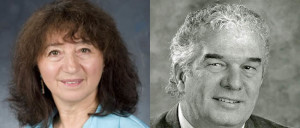Opinion: Waiting at the End of the Road

By Beverly Sabourin and Peter Globensky
This April 22 marks the 51st anniversary of the first Earth Day in 1970. Millions of people the world over took part. It provided human energy to the birth of the environmental movement as the day focused on the degree of environmental degradation let loose upon Mother Earth by Western “civilization”. It acknowledged that we had set an example for all to follow in paying homage to the god of progress. Inspired by exhortations of biblical proportions, we had truly learned to become “fruitful and multiply and fill the earth and subdue it, and have dominion over the fish of the sea and over the birds of the heavens and over every living thing that moves on the earth.”
Despite this annual celebration which encourages us to consider our individual and collective impacts on the planet, the past 50 years have clearly demonstrated that our addiction to conveniences has carved a wide path of destruction and mayhem on our earthly home. From droughts to raging fires, species extinction to ravaged habitats and ecosystems, we and the governments we elect have abandoned our role as stewards of the earth – a bloody sacrifice on the altar of progress. With global warming and the climate emergency it has wrought, we now face the greatest existential threat to our existence in human history. And we have done so for one elemental, over-arching and cultural reason: the earth is no longer hallowed ground, a sacred place. We take more than what we need and dump back what we discard.
Conservationists, scientists and environmentalists have not been the only ones who have been beating the drums of warning. Indigenous Elders have been sounding the alarm for decades. The well-spring of that anxiety has not only emerged from their witness to the devastation inflicted upon Mother Earth, but from an even deeper well of consciousness — an inalienable belief in the sacredness of place and the interconnected web which links us all in the circle of being.
Despite the variation and complexity of the creation stories and cultures among Indigenous peoples, there is a fundamental commonality uniting the belief systems of Indigenous communities – a reverence for the land and a respect for all manner of life upon it. This is not some romanticized fairy tale of kumbaya bliss. The reverence for and the sacredness of the land was synonymous with the realization that their very survival depended upon it. But it has always been more than that. Mother Earth is creation itself and the Creator is intrinsic within her.
There is also a dawning realization that Indigenous Peoples, particularly those in the north of Canada are suffering the effects of environmental racism. Our out-of-sight, out-of-mind dependence on the extraction of natural resources and the use of fossil fuels to process them have made too many of us oblivious to the impacts global warming have had on Indigenous communities. We have colonized the lands as well. It has been difficult to hear the voices of the Elders over the sounds of the bulldozers and chainsaws. Perhaps our salvation lies in the return of all these public lands to the governance of these Elders!
In the late 1970s, eminent British scientist James Lovelock wrote, The Gaia Hypothesis. Named after the Greek goddess of the earth, he proposed that Gaia is a self-regulating system where both the animate and inanimate interact with each other to maintain life on earth. Widely rejected then, how prescient it has become now. We continue to struggle with both the idea and reality of nature. How ironic that it is seen as “other-worldly” as something visited, an old-fashioned Kodak-moment that we can look at and cherish in two dimensions. It is “out there” lurking on the fringes. It lies in wait, beyond where we live, brutally, and constantly honest – all of which confronts our own ability to live within it. We are in pain for the loss of beauty not knowing its cause. When we separate ourselves from the sacredness of Earth, we dishonour the womb of our origins. We alienate ourselves from ourselves.
On the first Earth Day in 1970 when Lovelock was developing his theory, the world population was 3.7 billion. One hundred years ago it was but half that. On this Earth Day, we stand at 7.8 billion well on our way to a projected 10 billion people by 2050. We have indeed been fruitful and multiplied and our collective weight continues to subdue the earth and all that is upon it.
Waiting at the End of the Road
For the wilderness in which we have languished
Has been one of our assembly
It is a seared and barren place
Truly a darkling plane
Submitting no succour to parchment souls.
A dun-coloured, dried and shrivel terrain
Cracked from lack of tears, scorched to dry bones
Where the lick of salt is empty of purpose,
Where self is all that was and the future
Condemns us to the present.
Where faith ends with what we are,
And hope, warranted or not, is but the glimpse
Of a forlorn memory, melancholy at the loss of
Wonder, and enchantment
Hope! It is but a shoddy canvas tent
Shivering in a bitter wind.
PAG ~ with inspiration from Matthew Arnold and Cormac McCarthy
Beverly Sabourin is a former Director of the Indigenous Access Program at Red River College (Winnipeg) and retired as the Vice-Provost of Aboriginal Initiatives at Lakehead University and is a member of the Pic Mobert Ojibwe. Peter Andre Globensky is a former senior policy advisor on Indigenous Affairs in the Office of the Prime Minister and retired as CEO of the Canadian Council of Ministers of the Environment. They invite your comments at basa1@shaw.ca


